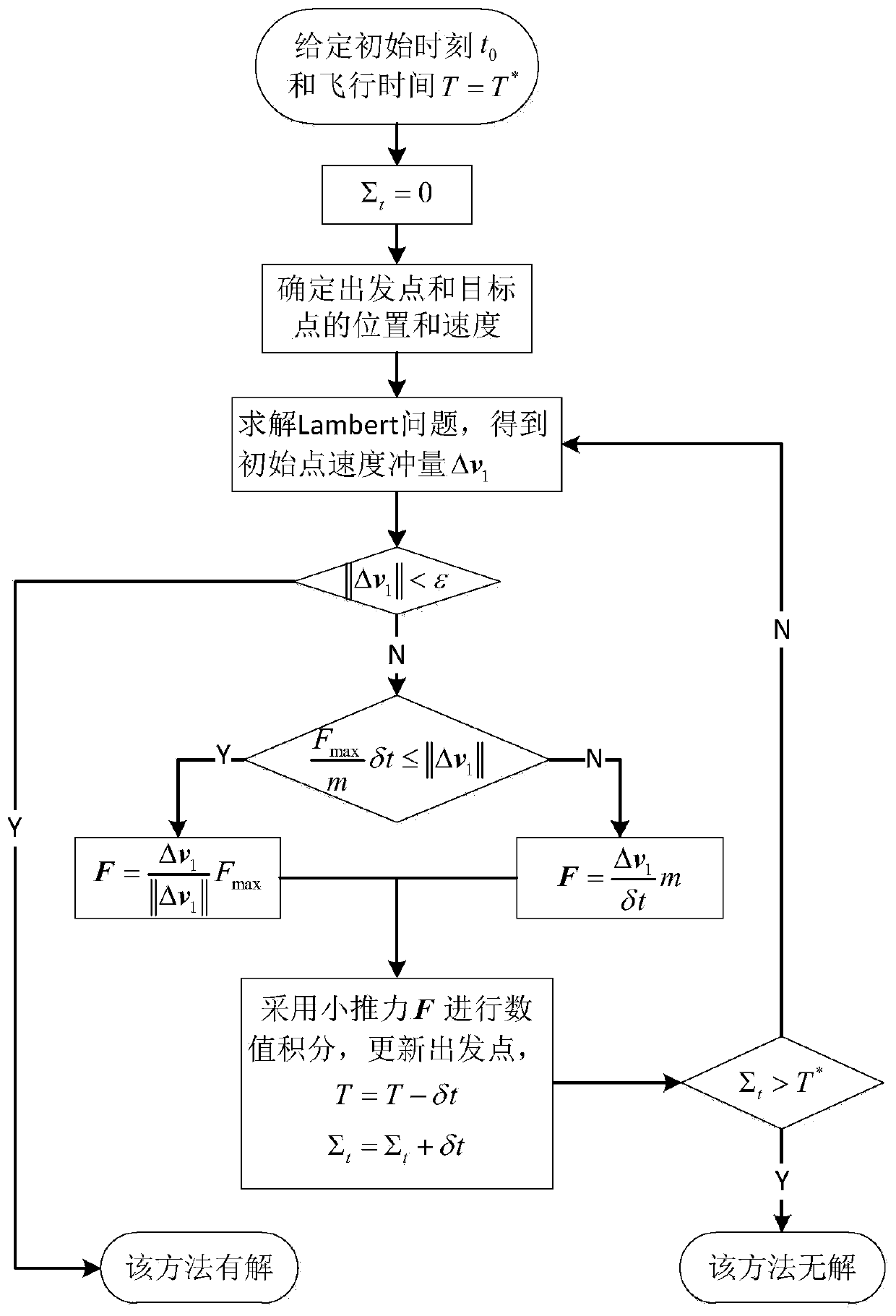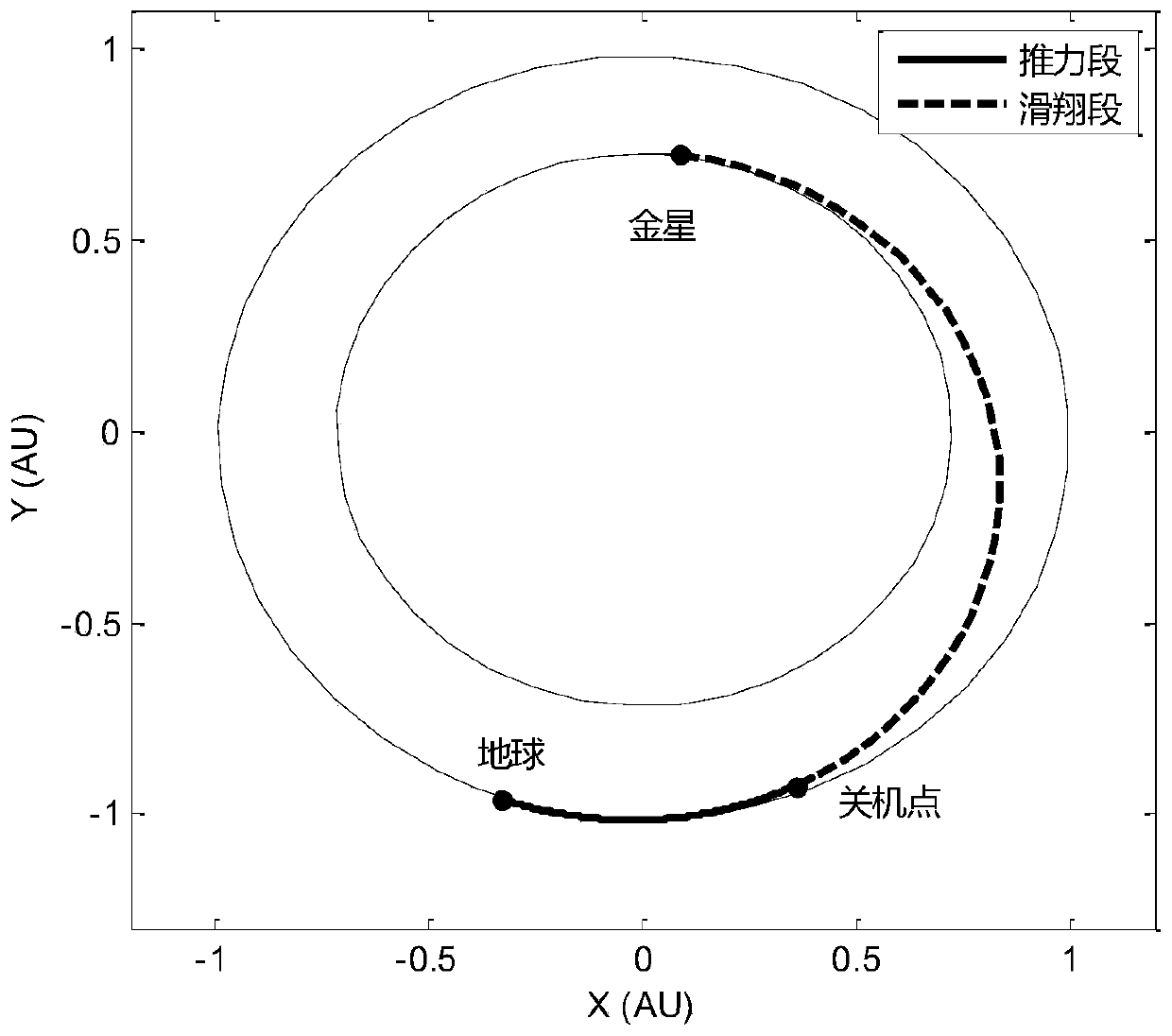Method and system for quickly generating deep-space small-thrust flying-over orbit
A small thrust and orbital technology, applied in special data processing applications, instruments, electrical digital data processing, etc., can solve problems such as slow calculation speed, large calculation amount, and reduce calculation amount, and achieve the effect of avoiding the global optimization process
- Summary
- Abstract
- Description
- Claims
- Application Information
AI Technical Summary
Problems solved by technology
Method used
Image
Examples
Embodiment 1
[0027] as attached figure 1 As shown, the embodiment of the present invention provides a method for quickly generating a low-thrust flyover orbit in deep space, including the following steps:
[0028] S1, given starting point position r 0 and the target point position r f and the starting point velocity v 0 , the flight time from the starting point to the target point T=T * , and initialize the current time t 0 and the integrated time variable Σ t ;
[0029] S2, by solving the Lambert problem, the velocity increment Δv is obtained 1 ;
[0030] S301, in the speed increment amplitude ||Δv 1 When || is less than the impulse threshold ε, the speed increment Δv 1 It is transformed into a small thrust vector F; when the above-mentioned speed increment amplitude meets the set impulse threshold ε, it means that the calculation procedure of this scheme has a solution, and the small thrust vector can be obtained according to Newton’s second law, and can be obtained according to...
Embodiment 2
[0036] As a further improvement of Embodiment 1, continue to refer to figure 1 :
[0037] S1, given starting point position r 0 and the target point position r f and the starting point velocity v 0 , the flight time from the starting point to the target point T=T * , and initialize the current time t 0 and the integrated time variable Σ t ;
[0038] S2, by solving the Lambert problem, the velocity increment Δv is obtained 1 ;
[0039] S302, in the speed increment amplitude ||Δv 1 || is greater than or equal to the impulse threshold ε, and satisfies When , output a small thrust vector:
[0040] Among them, F max is the maximum and minimum thrust that the propulsion system can output, m is the mass of the spacecraft, and δt is the integration time;
[0041] S4. Perform a numerical integration of the time length δt on the first-order dynamic equations of the classic two-body orbit of a classic spacecraft under the action of a small thrust vector, and update the sta...
Embodiment 3
[0046] As a further improvement of Embodiment 1, continue to refer to figure 1 :
[0047] S1, given starting point position r 0 and the target point position r f and the starting point velocity v 0 , the flight time from the starting point to the target point T=T * , and initialize the current time t 0 and the integrated time variable Σ t ;
[0048] S2, by solving the Lambert problem, the velocity increment Δv is obtained 1 ;
[0049] S303, in the speed increment amplitude ||Δv 1 ||When greater than or equal to the impulse threshold ε, and not satisfied When , output a small thrust vector:
[0050] Among them, F max is the maximum and minimum thrust that the propulsion system can output, m is the mass of the spacecraft, and δt is the integration time;
[0051] S4. Perform a numerical integration of the time length δt on the first-order dynamic equations of the classic two-body orbit of a classic spacecraft under the action of a small thrust vector, and update th...
PUM
 Login to View More
Login to View More Abstract
Description
Claims
Application Information
 Login to View More
Login to View More - R&D
- Intellectual Property
- Life Sciences
- Materials
- Tech Scout
- Unparalleled Data Quality
- Higher Quality Content
- 60% Fewer Hallucinations
Browse by: Latest US Patents, China's latest patents, Technical Efficacy Thesaurus, Application Domain, Technology Topic, Popular Technical Reports.
© 2025 PatSnap. All rights reserved.Legal|Privacy policy|Modern Slavery Act Transparency Statement|Sitemap|About US| Contact US: help@patsnap.com



